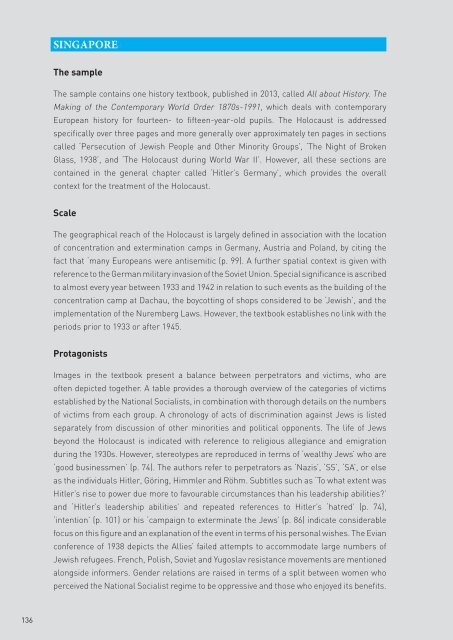228776e
228776e
228776e
You also want an ePaper? Increase the reach of your titles
YUMPU automatically turns print PDFs into web optimized ePapers that Google loves.
SINGAPORE<br />
The sample<br />
The sample contains one history textbook, published in 2013, called All about History. The<br />
Making of the Contemporary World Order 1870s-1991, which deals with contemporary<br />
European history for fourteen- to fifteen-year-old pupils. The Holocaust is addressed<br />
specifically over three pages and more generally over approximately ten pages in sections<br />
called ‘Persecution of Jewish People and Other Minority Groups’, ‘The Night of Broken<br />
Glass, 1938’, and ‘The Holocaust during World War II’. However, all these sections are<br />
contained in the general chapter called ‘Hitler’s Germany’, which provides the overall<br />
context for the treatment of the Holocaust.<br />
Scale<br />
The geographical reach of the Holocaust is largely defined in association with the location<br />
of concentration and extermination camps in Germany, Austria and Poland, by citing the<br />
fact that ‘many Europeans were antisemitic (p. 99). A further spatial context is given with<br />
reference to the German military invasion of the Soviet Union. Special significance is ascribed<br />
to almost every year between 1933 and 1942 in relation to such events as the building of the<br />
concentration camp at Dachau, the boycotting of shops considered to be ‘Jewish’, and the<br />
implementation of the Nuremberg Laws. However, the textbook establishes no link with the<br />
periods prior to 1933 or after 1945.<br />
Protagonists<br />
Images in the textbook present a balance between perpetrators and victims, who are<br />
often depicted together. A table provides a thorough overview of the categories of victims<br />
established by the National Socialists, in combination with thorough details on the numbers<br />
of victims from each group. A chronology of acts of discrimination against Jews is listed<br />
separately from discussion of other minorities and political opponents. The life of Jews<br />
beyond the Holocaust is indicated with reference to religious allegiance and emigration<br />
during the 1930s. However, stereotypes are reproduced in terms of ‘wealthy Jews’ who are<br />
‘good businessmen’ (p. 74). The authors refer to perpetrators as ‘Nazis’, ‘SS’, ‘SA’, or else<br />
as the individuals Hitler, Göring, Himmler and Röhm. Subtitles such as ‘To what extent was<br />
Hitler’s rise to power due more to favourable circumstances than his leadership abilities’<br />
and ‘Hitler’s leadership abilities’ and repeated references to Hitler’s ‘hatred’ (p. 74),<br />
‘intention’ (p. 101) or his ‘campaign to exterminate the Jews’ (p. 86) indicate considerable<br />
focus on this figure and an explanation of the event in terms of his personal wishes. The Evian<br />
conference of 1938 depicts the Allies’ failed attempts to accommodate large numbers of<br />
Jewish refugees. French, Polish, Soviet and Yugoslav resistance movements are mentioned<br />
alongside informers. Gender relations are raised in terms of a split between women who<br />
perceived the National Socialist regime to be oppressive and those who enjoyed its benefits.<br />
136




